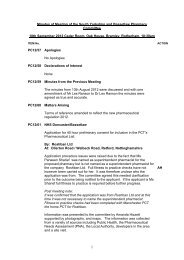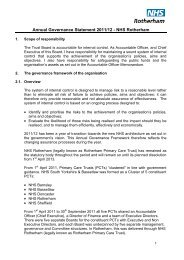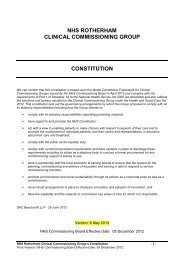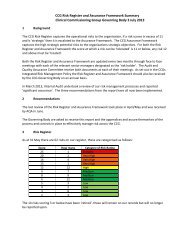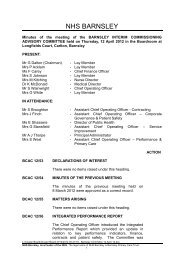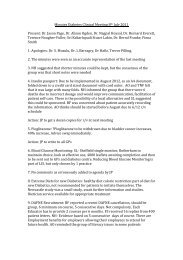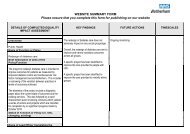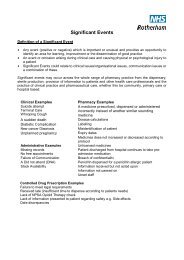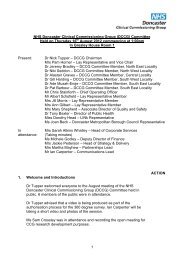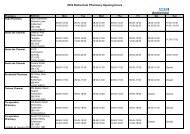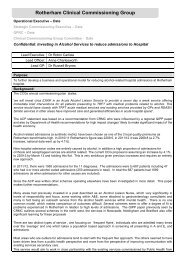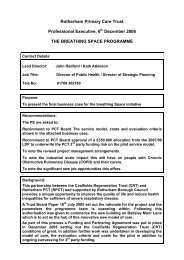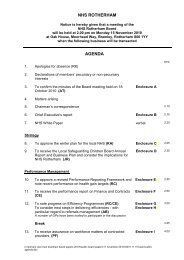Investment Planning and Management Process ... - NHS Rotherham
Investment Planning and Management Process ... - NHS Rotherham
Investment Planning and Management Process ... - NHS Rotherham
You also want an ePaper? Increase the reach of your titles
YUMPU automatically turns print PDFs into web optimized ePapers that Google loves.
<strong>NHS</strong> <strong>Rotherham</strong> Prioritisation Framework<br />
To be a World Class Commissioner <strong>NHS</strong>R needs to have robust processes for prioritising investment to improve<br />
population health (WCC competency 6.1).<br />
Currently there are at least five situations where prioritisation decisions are made:<br />
1. Individual case decisions (currently the Effective And Appropriate Health Care document is used as part of the<br />
<strong>Process</strong> for making purchasing decisions for out of contract or restricted services– this is awaiting revision when new<br />
national guidelines are issued later in the year)<br />
2. PBC business case approval (uses a proforma with 10 criteria relating to prioritisation, deliverability <strong>and</strong> governance)<br />
3. PCT Business cases – no framework – either Board Decision or delegated to Chief Executive with no explicit<br />
framework.<br />
4. PCT existing spending – no explicit framework or process<br />
5. Specialised commissioning decisions - currently use draft Barnsley criteria (5 very general criteria)<br />
This paper is mainly concerned with PCT Business cases but similar principles should be applied in the other situations,<br />
in particular there is little difference in principle between new spending <strong>and</strong> existing spending. The criteria as agreed<br />
following a review of other PCT prioritisation frameworks.<br />
Prioritisation Criteria<br />
1. Evidence of need<br />
l Number of people with capacity to benefit<br />
l Quality <strong>and</strong> capacity of existing services<br />
l <strong>Rotherham</strong>’s comparative outcomes in this area<br />
2. Health impact<br />
l Strength of evidence that the proposal will bring about health gain -hierarchy of evidence from authoritative national<br />
guidance (e.g. NICE), high quality r<strong>and</strong>omised controlled trials to other evidence.<br />
l Amount of health gain in terms of extending life or increasing quality of life.<br />
3. Impact on health inequalities<br />
l Impact on health inequalities within <strong>Rotherham</strong>.<br />
l Impact on health inequalities between <strong>Rotherham</strong> <strong>and</strong> the national average<br />
4. Cost <strong>and</strong> cost effectiveness<br />
l Total cost of proposal.<br />
l Relationship between cost <strong>and</strong> health impact - ideally in terms of cost per QALY or life years.<br />
5. Affordability <strong>and</strong> timing<br />
l Overall cost in relationship to spend on this programme area <strong>and</strong> total <strong>NHS</strong>R spend.<br />
l Timing of the spend <strong>and</strong> timing of benefits.<br />
6. Public opinion<br />
l Evidence of dem<strong>and</strong> <strong>and</strong> acceptability<br />
7. Fit with strategy<br />
l National policy<br />
l <strong>NHS</strong>R Strategic plan, Better health, Better lives<br />
l Partners strategy e.g. RMBC.<br />
For further information or if you have any questions about the process please contact:<br />
Lydia George, ext 2116 or e-mail: Lydia.george@rotherhampct.nhs.uk or<br />
John Doherty, ext 2029 or e-mail: john.doherty@rotherhampct.nhs.uk<br />
Better Health,<br />
Better Lives<br />
<strong>Investment</strong> <strong>Planning</strong> <strong>and</strong> <strong>Management</strong> <strong>Process</strong>.. . . . . . . . . . . . . . . . . . . . . . . . . . . . . . . . . . . . . . 6



